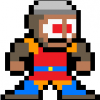As you mention Sprite i assume we are talking 2D here, So read what @burnt_casadilla said and generate a rectangle, this rectangle should represent the collision area of your sprite.
you already draw with something similar to this?
spriteBatch.Draw(SpriteTexture, SpritePosition, SpriteColor);
or
spriteBatch.Draw(spriteTexture, SpriteREct, SpriteColor);
So generate a rectangle like:
Rectangle collisionRect = new rectangle(SpritePosition.X, SpritePosition.Y, SpriteTexture.Width, SpriteTexture.Height);
Then using what I said, create a rectangle in Paint (or image editing program like Photoshop, Paint.NET etc.) which is ... i dunno 32x32. Create a 2px(or 1px) white border creating a transparent square in the center. Save this and Load it into your game using Content.Load<Texture2D>(...)
then simply, in your draw call:
// CollisionRectangleTexture - the texture we jsut created;
spriteBatch.Draw(CollisionRectangleTexture, collisionRect, Color.Red); //NOTE: the texture was created white, so when you specify a shade here, it appears as that colour.
There are other ways to achieve this: however i beleive this is the simplest, creating the texture as @Aurioch said, using a render-target is overkill imo.
3D primitive drawing @Dave Hunts idea would be more painful, if your just doing 2D unless you know what your doing, stay away from 3D drawing.










